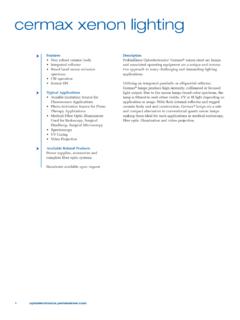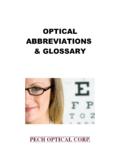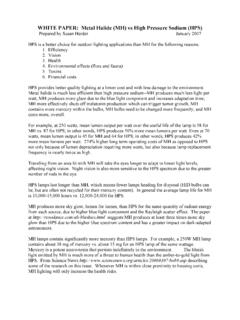Transcription of Night Operations - rev. 7/3/07 Flight Lesson: Night Operations
1 Flight lesson : Night OperationsObjectives:1. for the student to exhibit knowledge relating to the elements of Night Flight , including physiology, lighting, airport Operations , navigation, FARs2. gain experience flying at nightJustification:1. many flights require Night operations2. develops student s confidence in navigation and Night operations3. there are minimum Night requirements for the private pilot checkrideSchedule:ActivityEst. Ground: Night physiology the eye adaptation scanning Night equipment personal aircraft aircraft lighting airport lighting takeoff and departure navigation approaches and landings emergencies applicable FARsElements Air: Night takeoffs and landings Night cross countryCompletion Standards:1.
2 When the student understands the physiology of Night flight2. when the student understands the lighting configurations of airplanes and airports for Night operations3. when the student understands what is required of oneself and aircraft to be able to Flight at night4. when the student is able to competently takeoff, land, and navigate at nightCommon Errors: fails to use Night scanning technique to locate traffic high and fast landing approachNight Operations - rev. 7/3/071 of 6 Presentation Ground: Night Physiology1. The eye(1)light rays pass through the pupil of the eye and are focused by the lens onto the retina, which is a light sensitive layer at the back of the eye(2)conesi.
3 Central part of the retina contains cone cells, which are most effective in daylight and least effective in darknessii. cones allow us to see color, small details, and distant objects(3)rodsi. the outer band of the retina contains rod cells, which are responsible for your peripheral vision , and are effective in both daylight and darknessii. they are sensitive to movement, but not to detail or color, and so only register black, white, and gray2. adaptation(1)it takes the eyes about 30 minutes to adapt to a dark environment(2)the rate at which dark adaptation occurs depends on the contrast between the level of brightness and the level of darkness of the new environmenti.
4 For this reason, bright lighting should be avoided prior to Night flyingii. this is not to say, don t preflight with a flashlight or Flight plan in a dark room. just minimize the amount of exposureiii. the best thing to do is dim the cockpit lights during taxi(3)also, smoking reduces the amount of oxygen your body gets, and thus should also be avoidedi. it can be equivalent to adding 5000 ft in altitudeii. fatigue, colds, alcohol, etc. effect Night vision3. scanning for other aircraft(1)since rods are the only sensitive cells in your eyes at nighti. scanning should be done with off center viewing (peripheral view)ii. you will see objects better when your eyes are looking to one side of the object at Night , rather than straight at them as in daylight(2)if you suspect traffic or an object somewhere, don t look directly at may cause it to become more invisible (3)scan small parts at a time4.
5 Other good habits(1)close one eye when exposed to bright light to reduce effects of blinding(2)move the eyes more slowly at Night (3)blink the eyes if they become blurry(4)concentrate on seeing objects(5)force the eyes to view off centerNight Equipment1. personal equipment(1)a flashlight is imperative to proper Night operationsi. provides adequate lighting for the pre- Flight inspectionNight Operations - rev. 7/3/072 of 6ii. colored lens (red or orange) is better for cockpit uses because it will minimize ruining your Night vision (i) note: colored lens may reduce your ability to see certain colors ( on a chart)2. aircraft equipment(1)the equipment necessary for Night Operations can be remembered with two acronyms(2) day VFR - TOMATO FLAAMES: i.
6 Tachometerii. Oil pressureiii. Magnetic compassiv. Airspeed indicatorv. Temperature sensor (if liquid cooled)vi. Oil temperature gauge (if air cooled)vii. Fuel gaugesviii. Landing gear position indicator lightsix. Altimeterx. Anti-Collision lights (if manufactured after 3/11/1996)xi. Manifold pressure gaugexii. ELTxiii. Seat belts(3) Night VFR:i. Fuses (spares) or circuit breakersii. Landing lights (if for hire) iii. Anti-collision lights iv. Position Lightsv. Source of energy (adequate to power all electrical and radio equipment)3. aircraft lighting(1)Position lightsi. green on right, red on left, white on rearii.
7 Scenarios:(i) red-to-green is potentially dangerous(ii) same color to same color is safeiii. on required on between sunset and sunrise(2)anti-collision lightsi. can either be a red beacon or white strobe lightsii. they must be on at all times (except in the interest of safety)4. airport lighting(1)airport beaconi. designed to help a pilot visually locate an airport from some distance awayii. some transmit pulses of light, some rotate, but the effect is the same(i) Green - White - Green - White = civil airport(ii) G - W - W - G - W -W = military airport(iii) Yellow - W - Y - W = helicopter landing(2)taxiway lightingNight Operations - rev.
8 7/3/073 of 6iii. taxiways are lit in two possible ways(i) two lines of blue lights that mark the edges of the taxiway(ii) one line of green lights marking the center of the taxiwayiv. centerline lights are flush (or almost) with the ground and ca be taxied overv. edge lights are not flushvi. there may be red stop bars installed, indicating where an airplane should hold position(3)runway lightingi. runway lighting defines the boundaries of the actual landing areaii. some advanced systems provide distance down the runway information as well(i) not necessary for VFR pilots who should be able to see the end of the runwayiii. runway edge lights :white lights that outline the edges of runways during periods of restricted visibility or darknessiv.
9 Runway end lights :have two colors, showing green at the near end to the aircraft on approach, and red to the airplanes stopping at the far endv. runway end identified lights (REIL) :pair of synchronized flashing white lights located on each side of the runway threshold at the approach end(i) server to identify runways surrounded by lots of other lights, or in poor visibility(4)visual approach slope indicators (VASI)i. two bar red-on white VASI(i) red over white- on glide path(ii) white over white - above glide path(iii) red over red - below glide path(iv) only provides guaranteed obstacle clearance 4 NM out from threshold(5)pilot controlled lightingi.
10 At some airports when ATC and/or FSS are not manned 24 hours a day, airborne control of the lighting by the pilots is sometimes available using a VNF-COM frequency (usually the CTAF)ii. The A/FD specifies the type of PCL available and the frequency it is activated on(i) sectional and terminal charts have a * next to lighting indication if some limitations on lighting exist a. usually this implies pilot controlled lightingiii. to activate, key the mike between 3 and 7 times within 5 seconds.(i) this will give low, medium, or high intensity depending on how many keys, and what is availableiv. lights will stay on for 15 minutes from last keying so reactivation is a good idea as you enter the patternTakeoff and Departure1.








